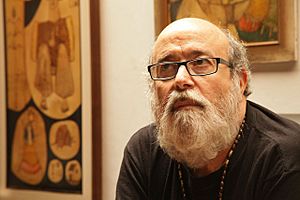Fernando Llort facts for kids
Fernando Llort Choussy (born April 7, 1949 – died August 10, 2018) was a famous Salvadoran artist. Many people called him "El Salvador's National Artist." He was known for his unique, colorful art style.
Fernando Llort was a very passionate person. He cared deeply about spirituality, religion, and his community. When he first traveled abroad, he thought about becoming a priest. But his love for art was stronger, and he decided to follow that path instead.
He is famous for teaching people in the small town of La Palma, Chalatenango, how to create art and earn money from it. His art is bright and often looks like something a child might draw. Some compare his style to famous artists like Joan Miró and Pablo Picasso.
Contents
About Fernando Llort
His Early Life and Family
Fernando Llort was born in San Salvador, El Salvador, on April 7, 1949. His parents were Baltasar Llort and Victoria Choussy.
From a young age, Llort loved to create. He made ceramics and explored music. He was always trying new artistic things.
In 1973, Fernando Llort married Estela Chacón. They lived in La Palma, Chalatenango and raised their three children there until 1979. Then, they moved to San Salvador when the Civil War began.
Llort and Estela had three children: Juan Pablo, Angel Fernando, and Maria Jose. Maria Jose now helps manage her father's art business.
Fernando Llort passed away on August 10, 2018.
His Journey in Education
Fernando Llort started studying architecture at the University of El Salvador in the 1960s. However, he left the program early.
In 1966, he traveled to Medellín, Colombia, to study religion. You can often see religious symbols in his art, like churches, doves, or an all-seeing eye.
After Colombia, Llort spent three years studying in Europe. He earned a degree in Philosophy from the University of Toulouse in France. Then, he got a Theology degree from the Université catholique de Louvain in Belgium. While in Europe, he painted in his free time and even had his first art show in France.
During his time away, Llort felt a bit disconnected from his own culture. His art show in France helped him reconnect with his Mayan heritage and Latin American identity.
Later, Llort went to the United States to study at Louisiana State University. He took art, modern architecture, and English classes. But he didn't like how strict the education felt there. He also didn't like some parts of American society he saw. So, in 1971, he left the U.S. and returned to El Salvador.
Life After Studies
When Fernando Llort came back to El Salvador, he and his friends started a band called La Banda del Sol (The Sun Band). Their music was inspired by the 1960s Hippie movement and focused on religion and spirituality. These ideas later influenced his unique art style, known as estilo Palmeño.
In 1971, to escape problems in the country, Llort and other young artists moved to La Palma, Chalatenango. This was a small, poor town near the border with Honduras. Life in the mountains offered a peaceful escape.
The simple life and beautiful nature in La Palma greatly shaped his art. One day, Llort saw a child rubbing a capinol tree seed to reveal a white surface. This inspired him to use natural materials in his art. This idea became a key part of the estilo Palmeño.
Fernando Llort's Art Style
Creating the Palmeño Style
Fernando Llort's art was all about identity and spiritual beliefs. He spent ten years (1972-1979) in La Palma, Chalatenango, helping the local community. He taught workshops on woodworking and painting to the local farmers.
Llort started his first art workshop in La Palma. He taught people how to create crafts like painting and woodworking. He called his workshop La Semillia de Dios (The Seed of God).
By the late 1970s, La Palma became famous for its folk art in El Salvador. In 1981, Llort moved back to San Salvador. There, he opened his own art gallery and handicraft shop called El Arbol De Dios.
What is Estilo Palmeño?
Many people describe Estilo Palmeño as Naïve art. This means it doesn't need a lot of technical skill. Instead, it focuses on the story and meaning behind the artwork.
Fernando Llort's art wasn't about politics or the war in El Salvador. He wanted to strengthen the Salvadoran identity. He did this by showing landscapes, local symbols, and everyday life.
His art used simple shapes, bright colors, and dark outlines. It often featured groups of houses or hills to symbolize community. He also included religious symbols like doves and suns. Each piece often looked like a mosaic. This colorful, hopeful style was meant to be a contrast to the difficult times of the civil war.
Llort's goal was to "reconnect my roots as a Latin American, and help define our people in their human and spiritual dimensions."
Today, La Palma is well-known for its artists and craftspeople. Fernando Llort and other artists from San Salvador are seen as the founders of this art movement. It gave farmers a chance to learn art and find new ways to earn money. Llort even started a project to create the Center for Comprehensive Development. He taught art classes there.
When the civil war started in 1980, Llort moved back to San Salvador. But he still stayed connected with the people in the mountains.
His artwork was also seen on a large tiled mural he made for the Metropolitan Cathedral in San Salvador in 1997. This beautiful mural was later removed in 2012.
Images for kids
See also
 In Spanish: Fernando Llort para niños
In Spanish: Fernando Llort para niños



